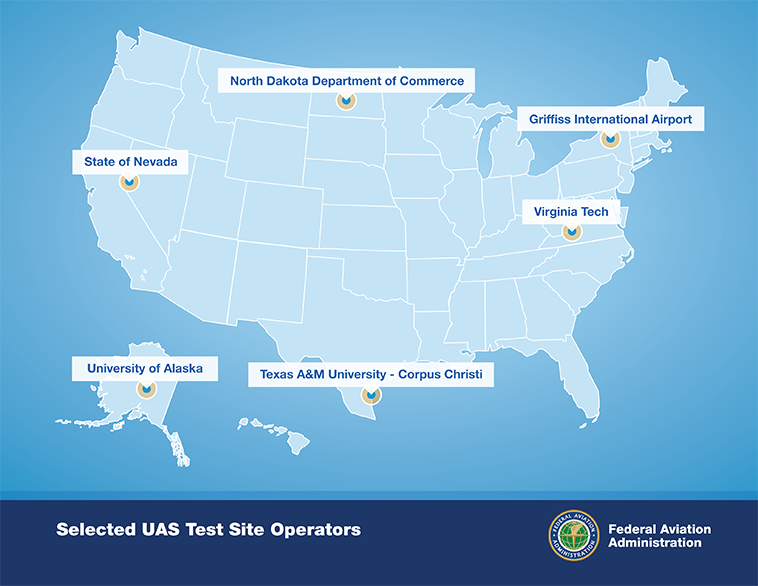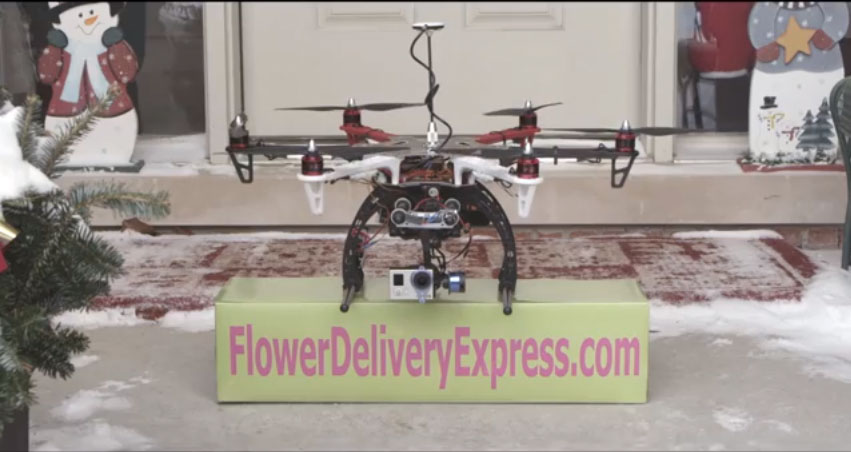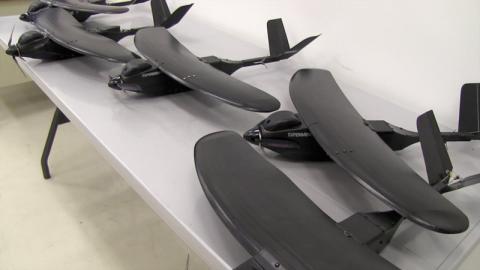The Federal Aviation Administration (FAA) and the Department of Defense (DoD) are enforcing limitations on who can use military airspace, a move that will curtail the number of possible places researchers can fly tests with unmanned aircraft.
The Federal Aviation Administration (FAA) and the Department of Defense (DoD) are enforcing limitations on who can use military airspace, a move that will curtail the number of possible places researchers can fly tests with unmanned aircraft.
The move appears to have surprised many in the unmanned community, including test site managers at some of the six organizations selected late last year to assist the FAA in introducing unmanned aerial systems (UASs) into the National Airspace System (NAS). The test sites will work with the agency to develop the rules and procedures for operating UASs.
A number of those organizations proposed using airspace restricted for defense use, although that was not taken into account when they were chosen, said the man in charge of airspace for the Air Force.
“Of the six, I believe four them identified military airspace as part of their proposal; and I think of those four, two or three identified restricted areas,” said Edward Chupein, chief of the Air Force Range and Airspace Division. “What I can tell you is, in the evaluation and selection of the test sites, the identification of Special Use Airspace, military airspace, as part of the project was not included in the decision making.”
“So, it never factored into whether anyone got it or didn’t get it,” Chupein added. “And since then each test site has met with the FAA, and the FAA has told them that that is not available.”
At the heart of the issue is who is actually in charge of the airspace in the United States — and it is the FAA not the Defense Department, even when it comes to the skies over U.S. military facilities.
"It is cut and dried,” said Chupein. “We are working within existing U.S. Code, FAA regulations, and DoD policy and service-level regulations that flow from those FAA regulations.
“The bottom line here is that it’s a question of authority. DoD does not have the authority to offer airspace for anything other than its intended military purpose,” Chupein added. “That authority rests entirely with the FAA. So, that’s been one of the misperceptions — that it is DoD airspace and installation commanders have the authority to offer this.
Rules, Hazards, and Airspace Designations
The issue involves “rulemaking airspace,” which is segregated for hazardous activities such as shooting from the air at targets on the ground. It is called rulemaking because the FAA went through the long federal process for making rules, including public scoping and publishing documents for public review and comment.
“It’s rulemaking like the FDA would do — or the FCC [Federal Communications Commission] or any federal agency when they’re actually making a rule as an executive organization,” said Chupein.
“Nonrulemaking” airspace is also a category, which is open to all visual flight rule traffic (VFR), including unmanned aircraft. This airspace may be used for military activities but only in cases where the military aircraft can avoid other aircraft.
“The way it’s defined by the FAA, it’s unseen hazards to flight. . . . It’s something that can’t see and avoid,” Chupein said. A military pilot, even one engaged in combat training, is still able to clear the way for other traffic and avoid a collision, he explained.
“Once the bomb falls from the airplane or once the laser energy is transmitted to the ground or the gun is fired — the projectiles, the bomb, the laser itself can’t do anything to avoid other traffic that may come through there,” he said. “It’s inherently hazardous.”
On the surface that would seem to suggest that rulemaking airspace is exactly where unmanned aircraft should go — because unammed aerial vehicles (UAVs) cannot themselves “see” other planes and get out of the way. In fact, see-and-avoid technology is one of the things that the FAA is supposed to be working on at its new test sites.
“The restricted areas are designated for hazardous activities, and unmanned aircraft are not hazardous activities,” said Chupein. “But why it’s coveted to be used by these organizations is because, by its very nature, it mitigates see and avoid. See and avoid is the very basis of the national airspace system, it’s your last measure of separation assurance and collision avoidance.”
Even though UAVs do not have see-and-avoid capability yet, the FAA has determined they do not need to be tested in restricted airspace where that shortcoming would not present a problem, said Chupein. “A lot of these civil developers would like to have the ability to segregate their activities, but they are not hazardous and the FAA has determined that it’s not necessary — there are other means to do that. That’s sort of where the conversation started.”
Since the FAA has authority over the airspace, could it change its approach to the limits at military facilities?
“I suppose they could,” said Chupein, “but since it’s rulemaking. that is often a fairly lengthy process that has to go through multiple rounds of public hearings and public comment periods. It would require them to almost create a new type of airspace to do this. And they would need a justification to do it.”
“If the mission of the FAA is the safety of the NAS, this would have to be a safety issue,” Chupein continued. “And it’s been determined that unmanned aircraft are not fundamentally unsafe. So, I don’t want to answer for the FAA, for sure. I’m just trying to let you know that is not as simple a solution as it may sound.”
The FAA did not respond to a request from Inside GNSS to comment on the issue.
Interagency Ambiguities
The confusion over who can make decisions about using the airspace may have come from the fact that the FAA asked the Pentagon to clarify the rules. In a November 26 letter to FAA Administrator Michael Huerta, Assistant Secretary of Defense Katrina McFarland noted that she had received the request and said that “in accordance with DoD Directive 5030.19, DoD Responsibilities on Federal Aviation, it is DoD policy to schedule regulatory and non-regulatory SUA [Special Use Airspace] for its intended military purposes.” If the air space is not needed, it is to be released to the FAA.
“Compliance with the directive precludes military organizations from scheduling SUA for the support of non-DoD activities,” McFarland’s letter stated. “Additionally there are no provisions within DoD Directive 5030.19 for local agreements that enable DoD to authorize use of airspace for the purpose of providing access to non-DoD organizations if those activities are not in direct support of a DoD requirement.”
Exceptions to the DoD policy do exist that would enable unmanned aircraft to fly in some military areas. In addition to the nonrulemaking airspace, civilian researchers could fly their AUVs at the Major Range and Test Facility Bases (MRTFBs), which are specifically designed for test and development type work. The MRTFBs can accommodate some civil activities, but civilian researchers would have to take a back seat to any military users.
“It’s fairly low priority, because we have quite a bit of testing going on and we’re near capacity,” said Chupein, “but there are certain circumstances where someone can come and say ‘Hey, we would like to use your facility, your airspace, your range, to do this sort of testing’ — and they’ll provide the engineering, the safety case analysis; even, perhaps some of the capabilities for telemetry, and things like that — on a cost basis, it’s available for direct costs.”
DoD is able to curtail activities for some limited periods, such as during holidays, and “release the airspace to the FAA,” wrote McFarland
Congress, however, is encouraging the FAA and DoD to look at easing limitations.
In the report accompanying the 2014 Defense Authorization Act, Congress directed the two agencies to “jointly develop and implement plans and procedures to review the potential of joint testing and evaluation of unmanned aircraft equipment and systems with other appropriate departments and agencies of the Federal Government that may serve the dual purpose of providing capabilities to the Department of Defense to meet the future requirements of combatant commanders and domestically to strengthen international border security.”
The agencies have until the end of September to report back on the status of the effort.
Ben Gielow, general counsel and senior government relations manager for the
Association for Unmanned Vehicle Systems International suggested a path to supporting more tests in military airspace could be found.
“We’re not raising any alarm bells now and hopefully this issue will get worked out,” Gielow told Inside GNSS. “If it doesn’t for some reason we’ll certainly start lobbying for it, but it’s not an immediate issue.”






